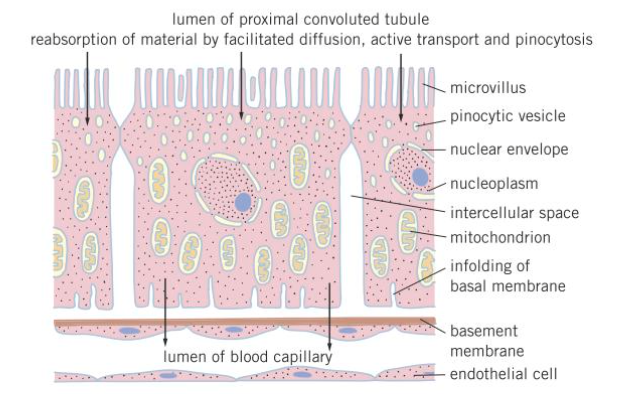Role of the nephron in osmoregulation
1/20
There's no tags or description
Looks like no tags are added yet.
Name | Mastery | Learn | Test | Matching | Spaced |
|---|
No study sessions yet.
21 Terms
What is osmoregulation?
control of the water potential of the blood
What links the afferent arteriole to the efferent arteriole?
glomerular capillaries
How is glomerular filtrate produced?
build up of hydrostatic pressure as the diameter of the afferent arteriole is greater than the diameter of the efferent arteriole
water, glucose, urea and mineral ions are squeezed out of PORES of the capillary endothelium
pass through the protein channels in the basement membrane
What cannot pass across into the Bowmans capsule?
blood cells and large proteins
The movement of the filtrate out of the glomerulus is resisted by what?
capillary endothelial cells
epithelial cells of the renal capsule
low water potential of the blood in the glomerulus
What are some modification that reduce the barrier to the flow of filtrate?
inner layer is made up of podocytes which have spaces between them - filtrate can pass BETWEEN them not through them
endothelium of the glomerular capillaries have spaces for filtrate to pass between/ PORES
In the proximal tubule, is all of the filtrate reabsorbed back into the blood?
nearly 85% is
What are some adaptations of the proximal convoluted tubules?
microvilli to provide a large surface area for reabsorption
infolding at their base for a large surface area for reabsobtion
lots of mitochondria for ATP production for active transport
How is glucose and water reabsorbed from the filtrate?
Na+ ions are actively transported out of the lining of the proximal convoluted tubule into blood capillaries which carry them away
Na+ ions diffuse down a concentration gradient from the lumen into the epithelial lining by facilitated diffusion
glucose / amino acids are co-transported with the sodium ions
molecules that are co-transported into proximal convoluted tubules then diffuse into the blood
movement of ions lowers water potential - water and urea leave filtrate into the epithelial cells and into capillaries
Where is the basement membrane found? What does it do?
acts as a selective barrier to prevent large molecules like proteins entering the blood

What are the 2 main regions of the Loop of Henle?
descending limb: narrow, thin walls, highly permeable to water
ascending limb: wider, thick walls, impermeable to water
The Loop of Henle acts as what?
a counter-current multiplier
The Loop of Henle is responsible for what?
reabsorbing water from the collecting duct
How is water lost from the descending limb of the Loop of Henle?
Na+ ions are actively transported out of the ASCending limb, into the interstitial space AND DESCENDING LIMB using ATP from many mitochondria in cells of its wall
This creates a lower water potential in the region of the medulla between the 2 limbs (interstitial space) - water can’t escape ascending limb as the thick walls are impermeable to water
Walls of descending limb are very permeable - water passes out of the filtrate by osmosis into the interstitial space
This water enters the blood capillaries by osmosis and is carried away
filtrate progressively loses water as it moves down the DESCending limb - reaches the lowest water potential at the tip of the hairpin
How is water lost from the collecting duct?
sodium ions diffuse out at the base of the ascending limb and are actively transported out the filtrate as it moves up the ascending limb
interstitial space (between ascending limb and collecting duct) has a lower water potential
water passes out the the filtrate by osmosis as it moves down the collecting duct into the blood vessels
Where is the water potential gradient in the interstitial space?
made highest water potential in the cortex and lower in the medulla
How is it a counter-current multiplier and what does this ensure?
water potential gradient is maintained along the whole length of the collecting duct
Why does the concentration of the filtrate remain the same in the PCT even though 99% of biological molecules are reabsorbed?
water is also being reabsorbed
How does the concentration of the filtrate change as it passed through the Loop of Henle?
concentration rises in descending limb as sodium ions enter and water is lost
concentration falls in the ascending limb as water remains due to impermeability of the walls and sodium ions are actively transported out
What happens to the volume of urine produced if the water potential of the filtrate is lower?
less water is reabsorbed by osmosis in the collecting duct
so more urine is produced
If less water is reabsorbed what does this mean? (in general)
less water is reabsorbed BY THE BLOOD